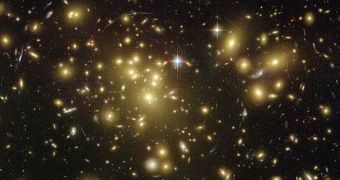Scientists with the Atomic Spectroscopy And Collisions Using Slow Antiprotons (ASACUSA) say that they managed to obtain the most accurate measurements on the weight of dark matter. These results refine existing figures down to an uncertainty level of on part per billion.
The goal of scientists working with this instrument was to reveal the mass of the antiproton, the antimatter equivalent of a baryonic proton. Details of the work were published in this week's issue of the top scientific journal nature.
According to physicists, the most important implication of the new investigation is opening up a new avenue of research for astrophysicists seeking to determine why the Universe is not made up of equal amounts of matter or antimatter.
In fact, what experts are ultimately trying to determine is why the equal amounts of the two stuff that were produced during the Big Bang did not annihilate each other completely. Normal, baryonic matter somehow won in this struggle, as evidenced by the fact that we are here.
But physicists could never explain what happened that prevented the two opposite types of matter from colliding with, and annihilating, each other. By learning more about the nature of antimatter, it may be possible to answer this question.
This new study – conducted at the European Organization for Nuclear Research's (CERN) Large Hadron Collider (LHC) – sought to aid this effort, by providing the extremely precise measurements.
“Imagine measuring the weight of the Eiffel Tower. The accuracy we've achieved here is roughly equivalent to making that measurement to within less than the weight of a sparrow perched on top. Next time it will be a feather,” ASACUSA researcher Masaki Hori explains, quoted by Space.
“At present, we are very far from understanding what happened to all the antimatter that was created in equal proportion to matter in the Big Bang,” Swansea University physicist Mike Charlton adds. He wrote an editorial accompanying the Nature article describing the findings.
“This is a very satisfying result. It means that our measurement of the antiproton's mass relative to the electron is now almost as accurate as that of the proton,” says Hori, who is a project leader in the ASACUSA collaboration.
He adds that one of the sources of inaccuracy in measurements pertaining to matter and antimatter at such a low level stem from the fact that atoms have the natural tendency to wiggle and jiggle. This means that the exact mass of their components may never be established with 100 percent certainty.

 14 DAY TRIAL //
14 DAY TRIAL //